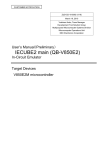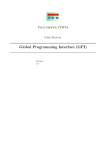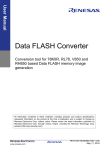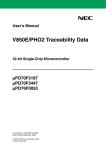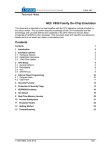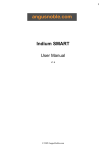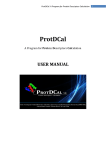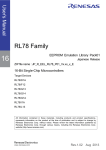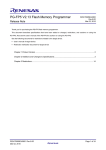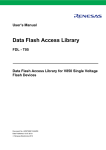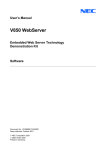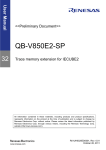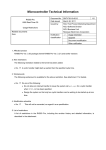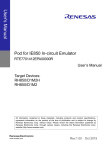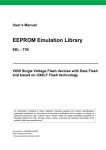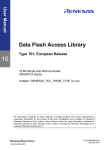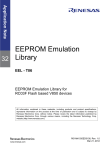Download Data FLASH Editor - Renesas Electronics
Transcript
User Manual Data FLASH Editor Data FLASH Editor tool for 78K0R and V850 based EEPROM Emulation All information contained in these materials, including products and product specifications, represents information on the product at the time of publication and is subject to change by Renesas Electronics Corp. without notice. Please review the latest information published by Renesas Electronics Corp. through various means, including the Renesas Technology Corp. website (http://www.renesas.com). www.renesas.com R01UT0176ED0000, Rev. 1.00 March 31, 2011 Notice 1. All information included in this document is current as of the date this document is issued. Such information, however, is subject to change without any prior notice. Before purchasing or using any Renesas Electronics products listed herein, please confirm the latest product information with a Renesas Electronics sales office. Also, please pay regular and careful attention to additional and different information to be disclosed by Renesas Electronics such as that disclosed through our website. 2. Renesas Electronics does not assume any liability for infringement of patents, copyrights, or other intellectual property rights of third parties by or arising from the use of Renesas Electronics products or technical information described in this document. No license, express, implied or otherwise, is granted hereby under any patents, copyrights or other intellectual property rights of Renesas Electronics or others. 3. You should not alter, modify, copy, or otherwise misappropriate any Renesas Electronics product, whether in whole or in part. 4. Descriptions of circuits, software and other related information in this document are provided only to illustrate the operation of semiconductor products and application examples. You are fully responsible for the incorporation of these circuits, software, and information in the design of your equipment. Renesas Electronics assumes no responsibility for any losses incurred by you or third parties arising from the use of these circuits, software, or information. 5. When exporting the products or technology described in this document, you should comply with the applicable export control laws and regulations and follow the procedures required by such laws and regulations. You should not use Renesas Electronics products or the technology described in this document for any purpose relating to military applications or use by the military, including but not limited to the development of weapons of mass destruction. Renesas Electronics products and technology may not be used for or incorporated into any products or systems whose manufacture, use, or sale is prohibited under any applicable domestic or foreign laws or regulations. 6. Renesas Electronics has used reasonable care in preparing the information included in this document, but Renesas Electronics does not warrant that such information is error free. Renesas Electronics assumes no liability whatsoever for any damages incurred by you resulting from errors in or omissions from the information included herein. 7. Renesas Electronics products are classified according to the following three quality grades: “Standard”, “High Quality”, and “Specific”. The recommended applications for each Renesas Electronics product depends on the product’s quality grade, as indicated below. You must check the quality grade of each Renesas Electronics product before using it in a particular application. You may not use any Renesas Electronics product for any application categorized as “Specific” without the prior written consent of Renesas Electronics. Further, you may not use any Renesas Electronics product for any application for which it is not intended without the prior written consent of Renesas Electronics. Renesas Electronics shall not be in any way liable for any damages or losses incurred by you or third parties arising from the use of any Renesas Electronics product for an application categorized as “Specific” or for which the product is not intended where you have failed to obtain the prior written consent of Renesas Electronics. R01UT0176ED0000 Rev. 1.00 User Manual 2 8. The quality grade of each Renesas Electronics product is “Standard” unless otherwise expressly specified in a Renesas Electronics data sheets or data books, etc. “Standard”: Computers; office equipment; communications equipment; test and measurement equipment; audio and visual equipment; home electronic appliances; machine tools; personal electronic equipment; and industrial robots. “High Quality”: Transportation equipment (automobiles, trains, ships, etc.); traffic control systems; anti-disaster systems; anti- crime systems; safety equipment; and medical equipment not specifically designed for life support. “Specific”: Aircraft; aerospace equipment; submersible repeaters; nuclear reactor control systems;medical equipment or systems for life support (e.g. artificial life support devices or systems), surgical implantations, or healthcare intervention (e.g. excision, etc.), and any other applications or purposes that pose a direct threat to human life. 9. You should use the Renesas Electronics products described in this document within the range specified by Renesas Electronics, especially with respect to the maximum rating, operating supply voltage range, movement power voltage range, heat radiation characteristics, installation and other product characteristics. Renesas Electronics shall have no liability for malfunctions or damages arising out of the use of Renesas Electronics products beyond such specified ranges. 10. Although Renesas Electronics endeavors to improve the quality and reliability of its products, semiconductor products have specific characteristics such as the occurrence of failure at a certain rate and malfunctions under certain use conditions. Further, Renesas Electronics products are not subject to radiation resistance design. Please be sure to implement safety measures to guard them against the possibility of physical injury, and injury or damage caused by fire in the event of the failure of a Renesas Electronics product, such as safety design for hardware and software including but not limited to redundancy, fire control and malfunction prevention, appropriate treatment for aging degradation or any other appropriate measures. Because the evaluation of microcomputer software alone is very difficult, please evaluate the safety of the final products or system manufactured by you. 11. Please contact a Renesas Electronics sales office for details as to environmental matters such as the environmental compatibility of each Renesas Electronics product. Please use Renesas Electronics products in compliance with all applicable laws and regulations that regulate the inclusion or use of controlled substances, including without limitation, the EU RoHS Directive. Renesas Electronics assumes no liability for damages or losses occurring as a result of your noncompliance with applicable laws and regulations. 12. This document may not be reproduced or duplicated, in any form, in whole or in part, without prior written consent of Renesas Electronics. 13. Please contact a Renesas Electronics sales office if you have any questions regarding the information contained in this document or Renesas Electronics products, or if you have any other inquiries. (Note 1) “Renesas Electronics” as used in this document means Renesas Electronics Corporation and also includes its majority- owned subsidiaries. (Note 2) “Renesas Electronics product(s)” means any product developed or manufactured by or for Renesas Electronics. R01UT0176ED0000 Rev. 1.00 User Manual 3 Regional Information Some information contained in this document may vary from country to country. Before using any Renesas Electronics product in your application, please contact the Renesas Electronics office in your country to obtain a list of authorized representatives and distributors. They will verify: Device availability Ordering information Product release schedule Availability of related technical literature Development environment specifications (for example, specifications for third-party tools and components, host computers, power plugs, AC supply voltages, and so forth) Network requirements In addition, trademarks, registered trademarks, export restrictions, and other legal issues may also vary from country to country. Visit http://www.renesas.com to get in contact with your regional representatives and distributors. R01UT0176ED0000 Rev. 1.00 User Manual 4 Table of Contents Chapter 1 1.1 1.2 1.3 Introduction .......................................................................... 7 Abbreviations...................................................................................................8 Features of Data FLASH Editor ......................................................................9 Trademarks ....................................................................................................10 Chapter 2 Documents / References.................................................... 11 Chapter 3 Input files / formats ............................................................ 12 Chapter 4 Output file / formats ........................................................... 14 Chapter 5 EEPROM emulation data of V850E/ES (MF2/UX4) ........... 15 5.1 5.2 5.3 5.4 Overview .......................................................................................................16 Section Header ..............................................................................................17 ID zone .......................................................................................................18 Data zone .......................................................................................................18 Chapter 6 6.1 6.2 6.3 6.4 Block structure overview ..............................................................................20 Section Header ..............................................................................................21 Reference zone ..............................................................................................23 Data zone .......................................................................................................24 Chapter 7 7.1 7.2 EEPROM emulation data of V850E2(UX6LF).................... 19 EEPROM emulation data of 78K0R(MF2) ......................... 25 EEL pool structure ........................................................................................25 EEL block structure.......................................................................................27 7.2.1 7.2.2 7.2.3 EEL block header ............................................................................................................28 Reference area .................................................................................................................29 Data area...........................................................................................................................29 Chapter 8 Software Installation .......................................................... 30 Chapter 9 Data FLASH Editor GUI ...................................................... 34 9.1 9.2 Toolbar .......................................................................................................35 The Menu .......................................................................................................35 9.2.1 9.2.2 9.2.3 9.2.4 9.2.5 9.3 File menu ..........................................................................................................................36 Settings menu ..................................................................................................................40 Tools menu.......................................................................................................................43 View menu ........................................................................................................................44 Help menu ........................................................................................................................45 Data FLASH window......................................................................................46 9.3.1 9.3.2 Add new EEPROM emulation data entry.......................................................................48 Edit EEPROM emulation data entry...............................................................................51 R01UT0176ED0000 Rev. 1.00 User Manual 5 9.3.3 9.4 9.5 Delete EEPROM emulation data entry...........................................................................54 Process window ............................................................................................54 Status bar .......................................................................................................55 Chapter 10 Error Messages .................................................................. 56 R01UT0176ED0000 Rev. 1.00 User Manual 6 Data FLASH Editor Introduction Chapter 1 Introduction The Data FLASH Editor is a windows based tool that allows to visualize and modify the EEPROM emulation data of a Data FLASH memory image of a 78K0R or V850 based microcontroller. The Data FLASH Editor does support memory images in the Intel-hex or Motorola-S record file format. The corresponding memory image can be generated by the Data FLASH Converter or it can be uploaded from a 78K0R or V850 based In-Circuit Emulator by using the IAR, GHS or Renesas debugger. The Data FLASH Editor supports to view, modify and to save EEPROM emulation data of an existing Data FLASH memory image. In addition, the Data FLASH Editor supports to add or remove EEPROM emulation data entries to respectively from a existing Data FLASH memory image. The Data FLASH Editor does distinguish between three different 78K0R and V850 based device families and FLASH Technologies: 78K0R: MF2 FLASH Technology in combination with the 78K0R/Fx3 EEPROM emulation library EEL (Type T03) V850E/ES: UX4 and MF2 FLASH Technology in combination with the V850 EEPROM emulation library EEElib (previous Type) V850E2: UX6LF FLASH Technology in combination with the V850 EEPROM emulation library EEL (Type T05) Different to V850E/ES device family, the Data FLASH Editor needs to read or to create an XML based raw data management description file first, to support 78K0R and V850E2 devices accordingly. This is caused by the different emulation library concepts of V850E/ES and V850E2, 78K0R. By reading or creating the raw data management description file the Data FLASH Editor gets the corresponding information about the data set IDs and data set length information. Based on this information only the latest valid IDs and matched data sets of a Data FLASH memory image file will be shown as validated data sets within the Data FLASH Editor window. The remaining data sets will be shown as invalidated data sets within the editor window. R01UT0176ED0000 Rev. 1.00 User Manual 7 Data FLASH Editor Introduction 1.1 Abbreviations Abbreviations Data FLASH EEPROM emulation FLASH FLASH Block EEL FAL FDL FSL FW FCB XML MF2 UX4 / MF2 UX6LF Description Embedded FLASH where mainly the data of the EEPROM emulation are stored. Beside that also code operation might be possible. In distinction to a real EEPROM the EEPROM emulation uses some portion of the flash memory to emulate the EEPROM behavior. To gain a similar behavior some side parameters have to be taken in account. “FLASH EPROM” - Electrically erasable and programmable nonvolatile memory. The difference to ROM is, that this type of memory can be re-programmed several times. A FLASH block is the smallest erasable unit of the FLASH memory. EEPROM Emulation Library FLASH Access Library (FLASH access layer) FLASH Data Library (Data FLASH access layer) FLASH Self-programming Library (accessing code FLASH) Firmware FLASH Control Block eXtensible Markup Language FLASH Technology of 78K0R based MCUs FLASH Technology of V850E/ES based MCUs FLASH Technology of V850E2 based MCUs Table 1 Abbreviations R01UT0176ED0000 Rev. 1.00 User Manual 8 Data FLASH Editor Introduction 1.2 Features of Data FLASH Editor Common features and features for V850E/ES(MF2/UX4) : NET Framework 2.0 based application User friendly and intuitive windows based graphical user interface. Visualization of EEPROM emulation data of a Data FLASH memory image. Modification of EEPROM emulation data entries: ADD, MODIFY or REMOVE. Loading of Data FLASH memory images generated by the Data FLASH Converter or IAR, GHS, Renesas debuggers. Restoring of modified EEPROM emulation data to an existing Data FLASH memory image. Enhanced features for V850E2(UX6LF) and 78K0R(MF2): Reading XML raw data management description file. Verifying of XML file based on device parameter file. Creation and modification of administration section within XML file. Sorting of data set based ID in the Data FLASH editor window. Handling data set state between validate and invalidate. Creating, saving and modifying of XML file. Selecting of data sets from Data FLASH memory image file based on XML file information. R01UT0176ED0000 Rev. 1.00 User Manual 9 Data FLASH Editor Introduction 1.3 Trademarks Green Hills, the Green Hills logo, CodeBalance, GMART, GSTART, INTEGRITY, and MULTI are registered trademarks of Green Hills Software, Inc. AdaMULTI, EventAnalyzer, G-Cover, GHnet, GHnetLite, Green Hills Probe,Integrate, ISIM, PathAnalyzer, Quick Start, ResourceAnalyzer, Safety Critical Products, Slingshot, SuperTrace Probe, TimeMachine, and TotalDeveloper are trademarks of Green Hills Software, Inc. IAR Embedded Workbench, visualSTATE, IAR MakeApp and C-SPY are registered trademarks of IAR Systems AB. Microsoft and Windows are registered trademarks of Microsoft Corporation. Adobe and Acrobat Reader are registered trademarks of Adobe Systems Incorporated. Windows and Windows Vista are either registered trademarks or trademarks of Microsoft Corporation in the United States and/or other countries. PC/AT is a trademark of International Business Machines Corporation. All other company, product, or service names mentioned in this documentation may be trademarks or service marks of their respective owners. R01UT0176ED0000 Rev. 1.00 User Manual 10 Data FLASH Editor Documents / References Chapter 2 Documents / References For more details on the EEPROM emulation concept of the V850 and 78K0R microcontroller families and the corresponding tools, please refer also to the documents below. Doc number Title Doc Type U18005EE1V2AN00 32-bit Single-Chip Microcontrollers V850 EEPROM Emulation Library Application Note U18042EE1V2AN00 32-Bit Single-Chip Microcontroller V850 Library for the Data Flash Access Layer Application Note U19003EE2V0UM00 Data FLASH Converter Conversion tool for data flash memory image generation Users Manual U20280EE1V0UM00 V850 Single Voltage Flash devices with Data Flash and based on UX6LF Flash technology EEPROM Emulation Library Users Manual R01AN0006ED0102 16 Bit Single-chip Microcomputer 78K0R/Fx3 Series EEPROM Emulation Library Application Note Table 2 Documents / References R01UT0176ED0000 Rev. 1.00 User Manual 11 Data FLASH Editor Input files / formats Chapter 3 Input files / formats A standard device parameter file, file name extension “*.pr5”, which is used in combination with the PG-FP5 FLASH programmer, is used also by the Data FLASH Editor to gain the corresponding Data FLASH information of the chosen V850 or 78K0R device. The device parameter file has to be loaded first, before any other operation can be performed. The Data FLASH Editor does support Data FLASH memory images in the Intelhex and Motorola-S record file format. Additionally for V850E2(UX6LF) and 78K0R(MF2) based devices, a XML raw data description file must be loaded or created before reading a corresponding Data FLASH memory image file in HEX or SREC format. The predefined tags of an XML based raw data description file are as following: DataFlash AdminstrativeSection FAL_CONFIG_DATAFLASH_SIZE FAL_CONFIG_BLOCK_SIZE EEL_CONFIG_BLOCK_START EEL_CONFIG_BLOCK_CNT EEL_CONFIG_DF_BASE_ADDRESS EEL_CONFIG_BLOCK_CNT_REFRESH_ THRESHOLD EEL_CONFIG_ERASE_SUSPEND_THRE SHOLD Record ID IDName Length Data Defining the start of the definition file. This section is describing the physical parameters that are needed for the file generation. Number of Data FLASH blocks, accessible by the FAL. Typical number of available Data FLASH blocks. Data FLASH block size in bytes. 1st block of the EEL pool. (Note) Number of blocks for the EEL pool. Data FLASH base address. Threshold for minimum number of prepared blocks. Threshold for erase suspend counter. Exceeding this result in warning. (Note) Defining the start of a ID-L record. Identifier for the data record (16bit). Format is fixed to four digits in hex. Defining the name off the record. Length definition of the data record. Any hexadecimal or decimal Note: These XML values were not used by 78K0R(MF2) based devices. The values were fixed to zero in case of 78K0R(MF2). Table 3 : Predefined tags of an XML based raw data description file R01UT0176ED0000 Rev. 1.00 User Manual 12 Data FLASH Editor Input files / formats <?xml version="1.0"?> <DataFlash> <AdministrativeSection> <FAL_CONFIG_DATAFLASH_SIZE>16</FAL_CONFIG_DATAFLASH_SIZE> <FAL_CONFIG_BLOCK_SIZE>0x800</FAL_CONFIG_BLOCK_SIZE> <EEL_CONFIG_BLOCK_START>2</EEL_CONFIG_BLOCK_START> <EEL_CONFIG_BLOCK_CNT>6</EEL_CONFIG_BLOCK_CNT> <EEL_CONFIG_DF_BASE_ADDRESS>0x2000000</EEL_CONFIG_DF_BASE_ADDRESS> <EEL_CONFIG_BLOCK_CNT_REFRESH_THRESHOLD>0x2</EEL_CONFIG_BLOCK_CNT_REFRESH_THRESHOLD> <EEL_CONFIG_ERASE_SUSPEND_THRESHOLD>10 </EEL_CONFIG_ERASE_SUSPEND_THRESHOLD> </AdministrativeSection > <Record> <ID>0x80</ID> <IDName>Name1</IDName> <Length>2</Length> <Data>0x20 0x30</Data> </Record> </DataFlash> Figure 1 Example of XML based raw data description file R01UT0176ED0000 Rev. 1.00 User Manual 13 Data FLASH Editor Output file / formats Chapter 4 Output file / formats The Data FLASH Editor can support Data FLASH memory images in the Intelhex and Motorola-S record file format. Additionally for the 78K0R(MF2) and V850E2(UX6LF) FLASH Technology, it can output the modified or newly created XML based raw data description file. Especially, if a data set is identified as invalidated it will be saved only to the XML file and it will be omitted in the output HEX or SREC file. R01UT0176ED0000 Rev. 1.00 User Manual 14 Data FLASH Editor EEPROM emulation data of V850E/ES (MF2/UX4) Chapter 5 EEPROM emulation data of V850E/ES (MF2/UX4) In opposite to a classical EEPROM, where the data is stored on a fixed address and so can always be found on the same location, EEPROM emulation need to store data on changing locations. From the different options to find the data during Read operations, the Renesas EEPROM emulation uses the way to bundle a certain set of data with one ID, that is then searched in memory on data Read. Writing new data sets is easily done, by appending the data to the data pool. Furthermore, the write granularity differs between real EEPROM and the Data FLASH used for EEPROM emulation. While the EEPROM can usually be written in 8-bit or 16-bit units, the Data FLASH must be written in 32-bit units (+1Bit for the ID-Tag, see below). Figure 2 EEPROM Data set representation The approach of using IDs to identify a set of data is in-line with AUTOSAR, as well as the ID size of 16 bits and length information of 16 bits. Differing from Code FLASH with 32-bit width, the currently implemented Renesas Data FLASH is 33-bit wide. The 33-rd bit is called the ID-Tag, indicating, that the word is information and not part of the data set itself. The current implementation in the EEPROM emulation layer sets this on the bottom ID-L, while keeping it unset on the data bits and on the top ID-L. Dedicated hardware on the Data FLASH macro can search for a certain ID by using this ID-Tag. R01UT0176ED0000 Rev. 1.00 User Manual 15 Data FLASH Editor EEPROM emulation data of V850E/ES (MF2/UX4) 5.1 Overview A EEPROM emulation Data FLASH section consists of 3 parts: Section Header Data Zone ID Zone Figure 3 EEPROM Emulation Section Overview R01UT0176ED0000 Rev. 1.00 User Manual 16 Data FLASH Editor EEPROM emulation data of V850E/ES (MF2/UX4) 5.2 Section Header Section header size is 16 Bytes (4 Words), where currently 3 words are used to define the current section status. Figure 4 Section Header The erase counter word consists of the 16-bit counter and a 16-bit inverse value for protection. It describes the number of erase cycles on the data section. The active marker and / or the consumed marker have the value 0x55555555. The value of a marker which is cleared is 0xFFFFFFFF (Blank Word). The following section states are possible: The following section states are possible: Prepared: The section has been erased. In the section header the erase counter is written. Active marker and consumed marker are cleared. This section is ready for activation by a Refresh operation. Active: The section contains the latest data sets. The EEPROM emulation can read and write data to this section. In the section header, additionally to the erase counter, also the active marker is set. Consumed marker is cleared. Consumed: The section is full, no more space was available to Write new data sets. After activating the next section and copying the latest data sets there, the Refresh operation marked the full section consumed. In the section header additionally, to the erase counter and active marker, also the consumed marker is set. Next step is to Prepare the section. Invalid: This is no valid state. During operation it can only occur in case of interruption of a FLASH operation like erase to this section. The section header may contain any other data except as described in the three states before. Also a completely erased FLASH (default factory delivery state) is invalid from EEPROM emulation point of view. The normal section state transitions are: Prepared --> Active --> Consumed --> Prepared -->... R01UT0176ED0000 Rev. 1.00 User Manual 17 Data FLASH Editor EEPROM emulation data of V850E/ES (MF2/UX4) 5.3 ID zone The ID-zone is a list of IDs of the data sets written to the section so far. The IDlist is dynamically generated during writing new data sets into the section. An IDList is required in order to simplify and to speed up Refresh operations (copying data sets from a full data section to a prepared one). The solution to keep the IDlist dynamically in the EEPROM Emulation FLASH space instead of keeping it statically in the Code FLASH area has been chosen, in order to allow new/added applications to store data sets with new IDs. The ID-zone grows by time in case of writing new data sets with new IDs. 5.4 Data zone The data zone contains the data sets. New data sets are simply appended after the last written data set. So the data zone grows down in the address space. The section is full and a Refresh is required, when there is no more enough erased space between ID zone and data zone for the data set to be written. R01UT0176ED0000 Rev. 1.00 User Manual 18 Data FLASH Editor EEPROM emulation data of V850E2(UX6LF) Chapter 6 EEPROM emulation data of V850E2(UX6LF) Beside the same kind of user data management based on data sets (DS) indentified with certain IDs, a new concept which called “Ring buffer style FLASH block management” is implemented in UX6FL EEL. The FLASH blocks are used as a kind of ring buffer, each block passing a complete of life cycle in each ring buffer rotation. last physical block 1’st physical block Figure 5 Block Lifecycle & Physical FLASH R01UT0176ED0000 Rev. 1.00 User Manual 19 Data FLASH Editor EEPROM emulation data of V850E2(UX6LF) 6.1 Block structure overview An EEPROM emulation Data FLASH block contains 3 areas: Section Header Data Zone Reference Zone Figure 6 Basic Block structure R01UT0176ED0000 Rev. 1.00 User Manual 20 Data FLASH Editor EEPROM emulation data of V850E2(UX6LF) 6.2 Section Header The block header size is 32 Bytes (8 Words). It contains the block status words. Figure 7 Section Header The references write pointer (RWP) points to the previous block separator between REF zone and Data zone. By that, the EEL knows for each occupied block the last REF zone entry. The RWP stability is ensured by the A - 1 word, written afterwards in the activation process. If the A - 1 word is valid, the RWP is electrically stable. Additionally, the RWP is checksum protected in order to be robust against accidental overwriting due to application failures Figure 8 Reference Write Pointer R01UT0176ED0000 Rev. 1.00 User Manual 21 Data FLASH Editor EEPROM emulation data of V850E2(UX6LF) The EEPROM emulation block header information decides the block status.The following block states are possible: Prepared: I–0 = 0xFFFFFFFF I–1 = 0xFFFFFFFF P = 0x55555555 A–0 = 0xFFFFFFFF A–1 = 0xFFFFFFFF I–0 = 0xFFFFFFFF I–1 = 0xFFFFFFFF P = 0x55555555 A–0 = 0x55555555 A–1 = 0x55555555 I–0 = 0x55555555 I–1 = 0x55555555 I–0 = 0 I–1 = 0 Active: Excluded: Invalid. R01UT0176ED0000 Rev. 1.00 User Manual 22 Data FLASH Editor EEPROM emulation data of V850E2(UX6LF) 6.3 Reference zone The Reference zone contains the Data Sets (DS) management information, basically which are the ID and the pointer to the data. Further information is required in the REF-zone to ensure data consistency in case of write interruption and in order to improve the robustness against user application fails resulting in FLASH words overwrite. SOR: Start of reference entry (1-bit Tag). It is written 1st in order to block one REF zone list entry DRP: Data Reference Pointer Is written after SOR and contains: - 16-bit lower half word: ID - 16-bit upper half word: widx, a pointer to the data. Especially, if widx is set to zero identifies that the DS is invalidated. EOP: End of DRP (1-bit Tag) It is written immediately after the DRP. When written, the read margin of the DRP word is ensured by the write sequence DCS: Data Check Sum This is a simple 32bit checksum, calculated over the user data and DRP. It ensures higher robustness (detection) on accidental overwriting of data or DRP. The DRP widx is excluded from the checksum. Additionally, by the write sequence it is ensured, that the read margin of the data is given, when the DCS is available Figure 9 DS Data and management information in FLASH R01UT0176ED0000 Rev. 1.00 User Manual 23 Data FLASH Editor EEPROM emulation data of V850E2(UX6LF) 6.4 Data zone The data zone contains the pure user data sets. New data sets are simply appended after the last written data set. So the data zone grows up in the address space. The block is full when there is no more enough space between REF zone and data zone for the data set to be written. R01UT0176ED0000 Rev. 1.00 User Manual 24 Data FLASH Editor EEPROM emulation data of 78K0R(MF2) Chapter 7 EEPROM emulation data of 78K0R(MF2) This chapter describes briefly the internal architecture of the EEL – T03 EEPROM Emulation Library. For more details please refer to the corresponding application note of the EEL – T03 EEPROM Emulation Library. 7.1 EEL pool structure The EEL pool is the virtual storage medium used by the EEL driver for storing data and block management information during its operation. From logical point of view the EEL-pool is organized as a single-linked ring of blocks. “Single-linked ring” means here: a) the next block to block N is block (N+1) b) the next block to the last one is the first one. Figure 10 Structure of an empty EEL pool (no data inside) Each block of the EEL-pool contains a block-header for storing block management information. Because the block indexing within the EEL-pool is based on the homogenous and fixed virtual block numbers 0x0000.... (EEL_POOL_SIZE - 1) it is not necessary to store the neighbors inside the block header. All flash-blocks of the EEL pool are grouped in three consecutive “regions” indicated by the “block status” in the block header. “active region” “invalid region” “prepared region” R01UT0176ED0000 Rev. 1.00 User Manual - consists of blocks containing active data - consists of blocks without active data - consists only of blocks ready to receive new data 25 Data FLASH Editor EEPROM emulation data of 78K0R(MF2) When contemplate EEL-pool blocks clockwise the regions are always in the same fixed chronological order: “prepared region” is before “active region” “active region” is before “invalid region” “invalid region” is before “prepared region” Figure 11 EEL pool regions during normal operation Block organization scheme based illustrated above offers following advantages: a) two symmetrical sections (where always 50% of data flash does not contain valid data) are not needed anymore b) the “active region” can grow and be adapted to the momentary need c) the reference area is separated from the data inside the same EEL block d) copy-processes are mostly much faster because reduced to the only last active block has to be released from valid instances. e) exclude functionality does not reduce performance of the driver R01UT0176ED0000 Rev. 1.00 User Manual 26 Data FLASH Editor EEPROM emulation data of 78K0R(MF2) 7.2 EEL block structure Each EEL block belonging to the EEL-pool is basically divided into three areas: the block header, reference area and the data area. The block-header contains information about the actual status of the block which is needed for the blockmanagement within the pool. The reference area contains reference entities off all instances written into this block during its live-cycle. It is necessary for actual data localization after power-on. The data area contains the pure data belonging to the corresponding references in reference area. Figure 12 EEL block, general structure R01UT0176ED0000 Rev. 1.00 User Manual 27 Data FLASH Editor EEPROM emulation data of 78K0R(MF2) 7.2.1 EEL block header The block header is a small area on the top of each flash block belonging to the EEL pool. It contains all information necessary for block management during EEL operation. The structure of the block header is the same in all blocks of the EELpool. Figure 13 EEL block header structure EEL block status header: Each flag within the block header consists of one flash word (4 bytes). There are two types of block status flags: - “constructive status flag” used in processes like “activation” and “preparation” - “destructive status flags” used in processes like “invalidation” and “exclusion” When reading the exact pattern 0x55555555 a “constructive” flag is TRUE When reading a pattern other than 0xFFFFFFFF a “destructive” flag is TRUE When setting “constructive” flag: 0x55555555 is written into the flag-word. When setting “destructive” flag: 0x00000000 is written into the flag-word. P_flag: A_flag: I_flag: X_flag: = 0x55555555 marks a “prepared” block that waits for data. = 0x55555555 marks an “active” block that may contain data ≠ 0xFFFFFFFF marks an “invalid” block (without valid data) ≠ 0xFFFFFFFF marks a block “excluded” from block management. EEL block erase counter: The block header word four contains the block erase counter. Its consistency is protected by an 8 bit checksum which is used by the EEL internally only. EEL previous reference write pointer: Its points the last RWP position of the previous block within the EEL pool. It is used by the EEL internally only. R01UT0176ED0000 Rev. 1.00 User Manual 28 Data FLASH Editor EEPROM emulation data of 78K0R(MF2) EEL exclusion erase counter: Stores the EC value at exclusion time. It is used by the EEL internally only. EEL Format In Progress (FIP) indicator: FIP<>0xFFFFFFFF indicates an FORMAT command discontinued by RESET. It marks the completely EEL pool as inconsistent and enforces the user to restart the FORMAT command. 7.2.2 Reference area The “reference area” is located in each EEL block directly behind the block header. It consists of so called reference entries that are used for instance identification, localization and for safeguarding during the read/write process. When writing new data into the EEL a corresponding reference entry is stacked in the reference area. The reference area is growing upstairs from lower widx to higher. 7.2.3 Data area The “data area” consists of data-records and is located on the bottom of each EEL pool block. Each data record within the data-area consists of pure data information without any data- frame. The data-frame information exists completely in the corresponding reference-entry in the reference-area. When writing new data into the EEL the data area is growing downstairs from higher widx to lower. R01UT0176ED0000 Rev. 1.00 User Manual 29 Data FLASH Editor Software Installation Chapter 8 Software Installation The Data FLASH Editor requires a Windows XP, Windows Vista or Windows 7 operating system installed on your personal computer. In additional, the .NET framework 2.0 must be installed on your personal computer to execute the Data FLASH Editor. To start the installation, please run the “setup.exe” installation program. During initialization phase of the setup program a progress bar is shown. Figure 14 Install preparation After the setup program has finished initialization a welcome screen appears. Click the Next button to continue the installation. Figure 15 Welcome screen R01UT0176ED0000 Rev. 1.00 User Manual 30 Data FLASH Editor Software Installation In the next step of installation, the License Agreement window appears. Please read the Software Program License Agreement carefully. To continue the installation accept the License agreement and click the Next button. If you not accepted the license agreement the installation procedure exits. Figure 16 License Agreement window The Destination Folder window appears. You might exit the installation by clicking the Cancel button. You can click the Change button to be able to change the installation destination path. Press the Next button to proceed with the installation. Figure 17 Choose Destination Folder window R01UT0176ED0000 Rev. 1.00 User Manual 31 Data FLASH Editor Software Installation After everything has been setup for installation, press the Install button to start the copy process and to finalize the installation. Figure 18 Ready to install window On the installation progress window you can follow the installation. You can always abort the installation by pressing the Cancel button. Figure 19 Installation progress window R01UT0176ED0000 Rev. 1.00 User Manual 32 Data FLASH Editor Software Installation When the installation is complete, the following message window appears. Figure 20 Installation completion window The program has been installed successfully and an entry has been made into the program menu to start the Data FLASH Editor software. The installation process is complete now and the setup utility has installed a new program folder which holds the Data FLASH Editor GUI Software and a Data FLASH Editor uninstall icon which allows you to remove the Data FLASH Editor software from your personal computer. Figure 21 Program folder after installation R01UT0176ED0000 Rev. 1.00 User Manual 33 Data FLASH Editor Data FLASH Editor GUI Chapter 9 Data FLASH Editor GUI The graphical user interface of the Data FLASH Editor allows an easy and an intuitive visualization and modification of the EEPROM emulation data of a loaded Data FLASH memory image. When starting the Data FLASH Editor GUI a screen similar to the following one will appear. Some commands and functions may be unavailable when the GUI is started for the first time, depending on Data FLASH area definition or the loaded Data FLASH memory image. <1> Menu bar <2> Tool bar <4> Process window <3> Data FLASH window <5> Status bar Figure 22 Data FLASH Editor main window R01UT0176ED0000 Rev. 1.00 User Manual 34 Data FLASH Editor Data FLASH Editor GUI The main window consists of the following areas. Name <1> Menu bar <2> Toolbar <3> Data FLASH window <4> Process window <5> Status bar Displayed items Menu items executable by the Data FLASH Editor Frequently used commands Shows the EEPROM emulation data of an loaded Data FLASH memory image, allows editing of EEPROM emulation data Shows tool command and process information Show current status and configuration of the Data FLASH Editor Table 4 Main window composition 9.1 Toolbar The toolbar contains buttons to configure the Data FLASH Editor. The following buttons and corresponding functions are offered by the Data FLASH Editor. Setup Data FLASH Display all EEPROM emulation data entries in 8-bit data format (byte format) Display all EEPROM emulation data entries in 16-bit data format (half-word format) Display all EEPROM emulation data entries in 32-bit data format (word format) Display all EEPROM emulation data entries in Decimal format Display all EEPROM emulation data entries in Hexadecimal format Table 5 Toolbar Buttons 9.2 The Menu Analogue to the Toolbar the main menu of the Data FLASH Editor allows the configuration and execution of all Data FLASH Editor functions. R01UT0176ED0000 Rev. 1.00 User Manual 35 Data FLASH Editor Data FLASH Editor GUI 9.2.1 File menu By using the File menu a Data FLASH memory image can be loaded, stored or if necessary closed. Additionally, the memory mapping of the Data FLASH area can be controlled via the File menu. (1) (2) (3) (4) (5) (6) (7) (8) Figure 23 File menu (1) Open Device Parameter File The Open Device Parameter File menu allows selecting and loading an existing Device Parameter File, which file name always includes the extension *.pr5. The Data FLASH Editor gets the device FLASH type e.g. V850E/ES(MF2/UX4), V850E2(UX6LF) or 78K0R(MF2) information from the device parameter file. Additionally for a V850E2(UX6LF) or 78K0R(MF2) based device more Data FLASH information like the block number, FLASH range, start address will be read from the device parameter file. By loading a new Device Parameter File the current configuration of the Data FLASH Editor is set to default. (2) Open XML File The Open XML File menu is only enabled for V850E2(UX6LF) and 78K0R(MF2) FLASH Technology based devices. It allows selecting and loading an existing XML based raw data description by the Data FLASH Editor. The XML file must fit to the selected Device Parameter File. Otherwise the Data FLASH Editor generates a corresponding error message. R01UT0176ED0000 Rev. 1.00 User Manual 36 Data FLASH Editor (3) Data FLASH Editor GUI Open HEX/SREC File The Open… menu allows selecting and loading an existing Data FLASH memory image by the Data FLASH Editor. After loading the Data FLASH memory image the corresponding Data FLASH entries are shown in the Data FLASH window. Figure 24 Open dialog Note: Before a Data FLASH memory image can be loaded the Data FLASH area must be specified within the Settings menu. In case of V850E/ES(MF2/UX4) the Data FLASH start address and size must be specified first. In case of V850E2(UX6LF) or 78K0R(MF2) an existing XML based raw data description file including Data FLASH management information must be loaded first. Note: When loading a Data FLASH memory image it must fit to the chosen Data FLASH start address and the Data FLASH size. Otherwise the file loading will be aborted and a corresponding error message is generated. R01UT0176ED0000 Rev. 1.00 User Manual 37 Data FLASH Editor Data FLASH Editor GUI The most recently used directory a file has been loaded from will be offered in this file open menu. The Data FLASH memory image can be loaded in two different formats, the Intel-hex or Motorola-S record file format. After a Data FLASH memory image is loaded, the corresponding EEPROM emulation data entries, including ID-tag, length and data record information were displayed in the Data FLASH window of the editor. Figure 25 Data FLASH window Additional to the Data FLASH memory the file reading process and the corresponding file and address map information are displayed in the process window. Figure 26 Process window (4) New HEX/SREC File The New HEX/SREC File menu is enabled only for V850E2(UX6LF) and 78K0R(MF2) FLASH Technology based devices. It allows preparing a new HEX/SREC file by the Data FLASH Editor. (5) Close HEX/SREC File Via the Close… menu the working on a Data FLASH memory image can be finished and the corresponding Data FLASH memory image will be closed. In case the Data FLASH memory image was changed a file save dialog offers the possibility to save the last changes. R01UT0176ED0000 Rev. 1.00 User Manual 38 Data FLASH Editor (6) Data FLASH Editor GUI XML File Save as… The Save as… menu is enabled only for V850E2(UX6LF) and 78K0R(MF2) FLASH Technology based devices. It allows saving of a modified or newly created XML file by the Data FLASH Editor. Especially, the invalidated data sets will be saved in the XML file and the memory space they occupied will be included in the data FLASH memory check function. (7) Save as HEX/SREC File The Save as HEX/SREC File menu allows saving of a modified Data FLASH memory image by the Data FLASH Editor. Especially for V850E2(UX6LF) and 78K0R(MF2) FLASH Technology based devices, the invalidated data sets will be ignored in the saved file. (8) Exit Via the Exit menu the Data FLASH Editor can be closed. In case the Data FLASH memory image was changed a file save dialog offers the possibility to save the last changes. In addition, the current Data FLASH Editor configuration is stored in the “CurrentSettings.xml” configuration file. The configuration file is located in the installation folder of the Data FLASH Editor. By restarting the Data FLASH Editor the latest settings are restored. Note: Write permissions to the installation folder and to the “CurrentSettings.xml”file are required to allow the storage of the current configuration settings by the Data FLASH Editor. R01UT0176ED0000 Rev. 1.00 User Manual 39 Data FLASH Editor Data FLASH Editor GUI 9.2.2 Settings menu Within the settings menu the corresponding Data FLASH settings can be displayed and modified. Figure 27 Settings menu The Setup Data FLASH menu allows to setup the corresponding Data FLASH of the chosen device. According to the FLASH Technology of the specified device V850E/ES(MF2/UX4) or V850E2(UX6LF) / 78K0R(MF2) two different setup menus will be displayed. R01UT0176ED0000 Rev. 1.00 User Manual 40 Data FLASH Editor Data FLASH Editor GUI Data FLASH setup for V850E/ES (MF2/UX4): For V850E/ES (MF2/UX4) based devices the Setup Data FLASH menu allows to setup the start address and the size of the Data FLASH area. By selecting this menu item the following dialog window appears and offers the possibility to specify the Data FLASH mapping. Figure 28 Setup Data FLASH start address Within the Data FLASH Settings dialog the start address of the Data FLASH area must be specified. Only hexadecimal input values are permissible. The entered start address should be equal to the physical start address of the Data FLASH area of the corresponding V850E/ES(MF2/UX4) device. The size of the Data FLASH can be specified by the pull-down menu. Supported sizes are 4 KByte, 8 KByte, 16 KByte and 32 KByte. Figure 29 Setup Data FLASH size Tip: After a Data FLASH memory image was loaded or edited, the Data FLASH Start Address can be modified by the user. This offers the possibility to generate and store the Data FLASH memory image for different memory locations. In case of V850E/ES(MF2/UX4) the debugging address space or otherwise the FLASH programmer address space can be specified. R01UT0176ED0000 Rev. 1.00 User Manual 41 Data FLASH Editor Data FLASH Editor GUI Data FLASH setup for V850E2(UX6LF) and 78K0R(MF2): For V850E2(UX6LF) and 78K0R(MF2) based devices the Data FLASH Settings menu allows to setup and modify the Administrative Section. This Administrative Section represents the Data FLASH mapping and partitioning of a V850E2(UX6LF) or 78K0R(MF2) based device. Additionally, by using the Data FLASH Settings menu the Administrative Section of an XML raw data description file including Data FLASH management information can be easily created. The tags of this section are predefined. The input values must match to the selected device parameter file. Figure 30 Administrative Settings Tip: After a Data FLASH memory image was loaded or edited, the Data FLASH Start Address can be changed by the user, by modifying the “EEL_CONFIG_DF_BASE_ADDRESS” entry. This offers the possibility to generate and store the Data FLASH memory image for different memory locations. In case of 78K0R(MF2) the debugging address space or otherwise the FLASH programmer address space can be specified. R01UT0176ED0000 Rev. 1.00 User Manual 42 Data FLASH Editor Data FLASH Editor GUI 9.2.3 Tools menu The Tools menu is enabled only for V850E/ES(MF2/UX4) FLASH Technology based devices. It controls the refreshing of the active Data FLASH section. In case EEPROM emulation data entries have been modified, remove or added, the “Refresh” function updates the active Data FLASH section and makes the changes valid. Figure 31 Tools menu R01UT0176ED0000 Rev. 1.00 User Manual 43 Data FLASH Editor Data FLASH Editor GUI 9.2.4 View menu By using the View menu the configuration of the Data FLASH Editor can be changed. The following functions are offered by the View menu. (1) (2) (3) (4) (5) (6) (7) Figure 32 View menu The functionality of each View menu items is described in the following table. (1) Toolbar (2) Status bar (3) Byte (4) Half-word (5) Word (6) Decimal (7) Hexadecimal Enables / Disables Toolbar Enables / Disables Status bar Display all EEPROM emulation data entries in 8-bit data format (byte format) Display all EEPROM emulation data entries in 16-bit data format (half-word format) Display all EEPROM emulation data entries in 32-bit data format (word format) Display all EEPROM emulation data entries in Decimal format Display all EEPROM emulation data entries in Hexadecimal format Table 6 View menu R01UT0176ED0000 Rev. 1.00 User Manual 44 Data FLASH Editor Data FLASH Editor GUI 9.2.5 Help menu Clicking the Help menu displays the following pull-down menu. Figure 33 Help menu The About Data FLASH Editor… command opens the “About Data FLASH Editor” window as shown below and indicates the program version. Figure 34 About Data FLASH Editor window R01UT0176ED0000 Rev. 1.00 User Manual 45 Data FLASH Editor Data FLASH Editor GUI 9.3 Data FLASH window The Data FLASH window visualizes the EEPROM emulation data records of a loaded Data FLASH memory image. The Data FLASH window supports the following functions: Display of EEPROM emulation data records, including: o ID tag o Length information o Invalidated state o Data o Format Modification of EEPROM emulation data: o Adding new EEPROM emulation data record o Editing of existing EEPROM emulation data record o Deleting existing EEPROM emulation data record o Invalidate/Validate existing EEPROM emulation data record The Data FLASH window is shown in the figure below. Figure 35 Data FLASH window R01UT0176ED0000 Rev. 1.00 User Manual 46 Data FLASH Editor Data FLASH Editor GUI The meaning of the different colours of the displayed EEPROM data records can be found in the following table. BLUE GREEN RED GRAY Original / unchanged EEPROM data record Modified EEPROM data record Added / new EEPROM data record Invalidated data record Table 7 EEPROM data record colouring By using the “Refresh” function in the Tools menu, all changes that have been done will be written to the active Data FLASH section. After the active Data FLASH section has been updated successfully, all EEPROM data records are displayed in blue colour. The functionality of each corresponding Data FLASH window button is described in the following table. Add new EEPROM emulation data entry Edit existing EEPROM emulation data entry Delete existing EEPROM emulation data entry Invalidate existing data record Recover or validate existing data record Table 8 Data FLASH window buttons R01UT0176ED0000 Rev. 1.00 User Manual 47 Data FLASH Editor Data FLASH Editor GUI 9.3.1 Add new EEPROM emulation data entry To add a new EEPROM data record, please press the “Add” button. The following screen does appear. (1) (2) (3) (4) (5) Figure 36 Add new data set menu The functionality of each Add menu item is described in the following table. (1) ID (2) Length (3) Data (4) Format (5) Size Identifier of the data record (ID tag). Only decimal values are supported Length definition of the data record. The minimum data length is equal to four bytes. The length can be specified in 4 Byte *n steps. Only decimal values are supported. Specifies the data record, any hexadecimal or decimal value. The data record must fit to the specified Length and format. Specifies the input and display format of the data record. Specifies the display size of the data record, the following sizes are supported: → 8-bit data format (byte format) → 16-bit data format (half-word format) → 32-bit data format (word format) Table 9 Add new data set items R01UT0176ED0000 Rev. 1.00 User Manual 48 Data FLASH Editor Data FLASH Editor GUI After a new EEPROM emulation data record has been entered, please press the <OK> button. Figure 37 Example 1, add new data set The new EEPROM data record is now visible, highlighted in red colour, in the Data FLASH window. Figure 38 Example 1, Data FLASH window (Add function) R01UT0176ED0000 Rev. 1.00 User Manual 49 Data FLASH Editor Data FLASH Editor GUI To make the changing valid and finally add the new EEPROM data record to the active Data FLASH section, please execute the “Refresh” function within the Tools menu. Figure 39 Example 1, refresh data set After the active Data FLASH section has been updated successfully, the new EEPROM data record is displayed in blue colour. Figure 40 Example 1, added new EEPROM data record R01UT0176ED0000 Rev. 1.00 User Manual 50 Data FLASH Editor Data FLASH Editor GUI 9.3.2 Edit EEPROM emulation data entry To edit an EEPROM data record, please mark the corresponding entry in the Data FLASH window and press the “Edit” button. Analogue to this, you can double-click on the corresponding EEPROM data record. The following screen does appear. (1) (2) (3) (4) (5) Figure 41 Edit data set menu The Edit menu does only support the modification of the data record, the format and the size. The ID and Length of the corresponding data record can not be changed. The functionality of each Edit menu item is described in the following table. (1) ID (2) Length (3) Data (4) Format (5) Size Current identifier of the data record (ID tag). Can not be modified. Current length of the data record. Can not be modified. Specifies the data record, any hexadecimal or decimal value. The data record must fit to the specified Length and format. Specifies the input and display format of the data record. Specifies the display size of the data record, the following sizes are supported: → 8-bit data format (byte format) → 16-bit data format (half-word format) → 32-bit data format (word format) Table 10 Edit data set items R01UT0176ED0000 Rev. 1.00 User Manual 51 Data FLASH Editor Data FLASH Editor GUI After an EEPROM emulation data entry has been modified, please press the <OK> button. Figure 42 Example 2, edit data set The modified EEPROM data record is now visible, highlighted in green colour, in the Data FLASH window. Figure 43 Example 2, Data FLASH window (Edit function) R01UT0176ED0000 Rev. 1.00 User Manual 52 Data FLASH Editor Data FLASH Editor GUI To make the changing valid and finally add the new EEPROM data record to the active Data FLASH section, please execute the “Refresh” function in the Tools menu. Figure 44 Example 2, refresh data set After the active Data FLASH section has been updated successfully, the new EEPROM data record is displayed in blue colour. Figure 45 Example 2, modified EEPROM data record R01UT0176ED0000 Rev. 1.00 User Manual 53 Data FLASH Editor Data FLASH Editor GUI 9.3.3 Delete EEPROM emulation data entry To delete an EEPROM data record, please mark the corresponding entry in the Data FLASH window and press the “Delete” button. Figure 46 Delete data set To delete the selected EEPROM data record, please press the <OK> button. To remove the selected EEPROM data record finally from the active Data FLASH selection, please execute the “Refresh” function in the Tools menu. 9.4 Process window The process window shows the executed tool commands and process information. Additionally it stores the command history. You can use the scroll bar to navigate through the command history. Figure 47 Process window R01UT0176ED0000 Rev. 1.00 User Manual 54 Data FLASH Editor Data FLASH Editor GUI 9.5 Status bar The status bar shows the actual status and configuration of the Data FLASH Editor. Status Data type Data size Data format (*) (*) = Only by loading a new Data FLASH memory image the selected data format will be taken under consideration. Changing the display format within the Settings menu after a Data FLASH memory was loaded has no influence and does not change the global format of the represented EEPROM emulation data entries. You can change the display format of an individual EEPROM emulation data entry in the Edit menu by double-clicking on it or using the “Edit” button within the Data FLASH window. Figure 48 Status bar R01UT0176ED0000 Rev. 1.00 User Manual 55 Data FLASH Editor Error Messages Chapter 10 Error Messages Error messages will be output in the error dialog boxes of the Data FLASH Editor. Figure 49 Error message, dialog box The following table shows the error messages generated by the Data FLASH Editor. Error Number Message / Description [E002] Could not open FLASH file! [E003] Could not read FLASH file! [E004] Could not save FLASH file! [E005] Could not load program configuration file <CurrentSettings.xml>! [E006] Could not write program settings XML file! [E007] Could not save XML file! [E008] The FLASH file contains checksum error! [E009] The FLASH file contains unknown lines! [E010] The FLASH file contains wrong Intel HEX lines! [E011] The FLASH file contains wrong Motorola SREC lines! [E012] The FLASH file contains wrong information! [E013] The data record could not be found! [E014] Active FLASH sector error when searching sector 0! [E015] Active FLASH sector error when searching sector 1! [E016] The active FLASH sector could not be found! [E017] Error during memory copy! [E018] FLASH file does not include data for RecordID <id>! [E019] The RecordID <id> has been deleted. A refresh is needed before it can be used again! [E020] The RecordID <id> is already used! [E021] Illegal character, must be an integer value, use digits 0-9! [E022] Error during decimal conversion, element=<id>! [E023] Error during hexadecimal conversion, element=<id>! [E024] The new data set does not fit in current FLASH! [E025] Problem to update empty FLASH space size! [E026] The length must be 4-65532 [E027] Error when ID should be inserted! [E028] Error when data should be inserted! R01UT0176ED0000 Rev. 1.00 User Manual 56 Data FLASH Editor Error Messages [E029] No inactive sector found! [E030] The sector is consumed and needs to be erased! [E031] The sector is already active! [E032] The length must be a multiple of 4! [E033] Error the data is not valid, element=<id>! The Data FLASH file does not match to the specified EEPROM emulation area! Data FLASH file address range (user data): <id1> - <id2> Specified EEPROM emulation area: <id3> - <id4> [E034] [E035] The Data FLASH file does not fill out the specified EEPROM emulation area. The file must have the same size as the EEPROM emulation area! Data FLASH file address range (user data): <id1> - <id2> Specified EEPROM emulation area: <id3> - <id4>" [E036] The ID must be a value from 1 to 65534! [E037] The file data exceeds the configured EEPROM emulation area! Data FLASH file address range: <id1> - <id2> Specified EEPROM emulation area: <id3> - <id4> [E038] The Data FLASH file is to large. Please import the Data FLASH file according to the specified Data FLASH settings. [E040] Wrong data FLASH base address specified. Please insert data FLASH base address as hexadecimal value! (for instance, Base address: 0x001F8000) [E041] Wrong data FLASH base address specified. The value has been updated according to alignment rules! [E042] A data set must be selected! [E043] Illegal start address! [E044] Wrong reference write pointer in block <blk> header section! Block number=<blk> [E045] The settings within XML file do not match to the device parameter file! [E046] The RecordID <ID> includes invalid characters in XML file! [E047] The RecordID <ID> value exceeds range (1-0xFFFE) in XML file! [E048] Same RecordID <ID> found in XML file! [E049] Inputs contains invalid characters! [E051] The Record length <length> exceeds range! [E052] The Record length <length> include invalid character in XML file! [E053] <name> value is out of range in XML file! [E054] Can not find valid data record in the FLASH file! [E055] length must be a value from (1-<max>)! [E057] Block <blk> RWP is wrong! [E059] Empty flash size is not enough to validate this data set! [E060] Data size might exceed active pool [E061] Could not open Device Parameter File! [E062] Could not read Device Parameter File! Table 11 Error Messages R01UT0176ED0000 Rev. 1.00 User Manual 57 Data FLASH Editor Error Messages Revision History Rev. Date 1.00 March 31, 2011 R01UT0176ED0000 Rev. 1.00 User Manual Description Page - Summary First Edition Issued. Replaces document U19829EE2V0UM00. 58 Data FLASH Editor SALES OFFICES Error Messages http://www.renesas.com Refer to "http://www.renesas.com/" for the latest and detailed information. Renesas Electronics America Inc. 2880 Scott Boulevard Santa Clara, CA 95050-2554, U.S.A. Tel: +1-408-588-6000, Fax: +1-408-588-6130 Renesas Electronics Canada Limited 1101 Nicholson Road, Newmarket, Ontario L3Y 9C3, Canada Tel: +1-905-898-5441, Fax: +1-905-898-3220 Renesas Electronics Europe Limited Dukes Meadow, Millboard Road, Bourne End, Buckinghamshire, SL8 5FH, U.K Tel: +44-1628-585-100, Fax: +44-1628-585-900 Renesas Electronics Europe GmbH Arcadiastrasse 10, 40472 Düsseldorf, Germany Tel: +49-211-65030, Fax: +49-211-6503-1327 Renesas Electronics (China) Co., Ltd. 7th Floor, Quantum Plaza, No.27 ZhiChunLu Haidian District, Beijing 100083, P.R.China Tel: +86-10-8235-1155, Fax: +86-10-8235-7679 Renesas Electronics (Shanghai) Co., Ltd. Unit 204, 205, AZIA Center, No.1233 Lujiazui Ring Rd., Pudong District, Shanghai 200120, China Tel: +86-21-5877-1818, Fax: +86-21-6887-7858 / -7898 Renesas Electronics Hong Kong Limited Unit 1601-1613, 16/F., Tower 2, Grand Century Place, 193 Prince Edward Road West, Mongkok, Kowloon, Hong Kong Tel: +852-2886-9318, Fax: +852 2886-9022/9044 Renesas Electronics Taiwan Co., Ltd. 7F, No. 363 Fu Shing North Road Taipei, Taiwan Tel: +886-2-8175-9600, Fax: +886 2-8175-9670 Renesas Electronics Singapore Pte. Ltd. 1 harbourFront Avenue, #06-10, keppel Bay Tower, Singapore 098632 Tel: +65-6213-0200, Fax: +65-6278-8001 Renesas Electronics Malaysia Sdn.Bhd. Unit 906, Block B, Menara Amcorp, Amcorp Trade Centre, No. 18, Jln Persiaran Barat, 46050 Petaling Jaya, Selangor Darul Ehsan, Malaysia Tel: +60-3-7955-9390, Fax: +60-3-7955-9510 Renesas Electronics Korea Co., Ltd. 11F., Samik Lavied' or Bldg., 720-2 Yeoksam-Dong, Kangnam-Ku, Seoul 135-080, Korea Tel: +82-2-558-3737, Fax: +82-2-558-5141 © 2010 Renesas Electronics Corporation. All rights reserved. Colophon 1.0 R01UT0176ED0000 Rev. 1.00 User Manual 59 Data FLASH Editor R01UT0176ED0000




























































